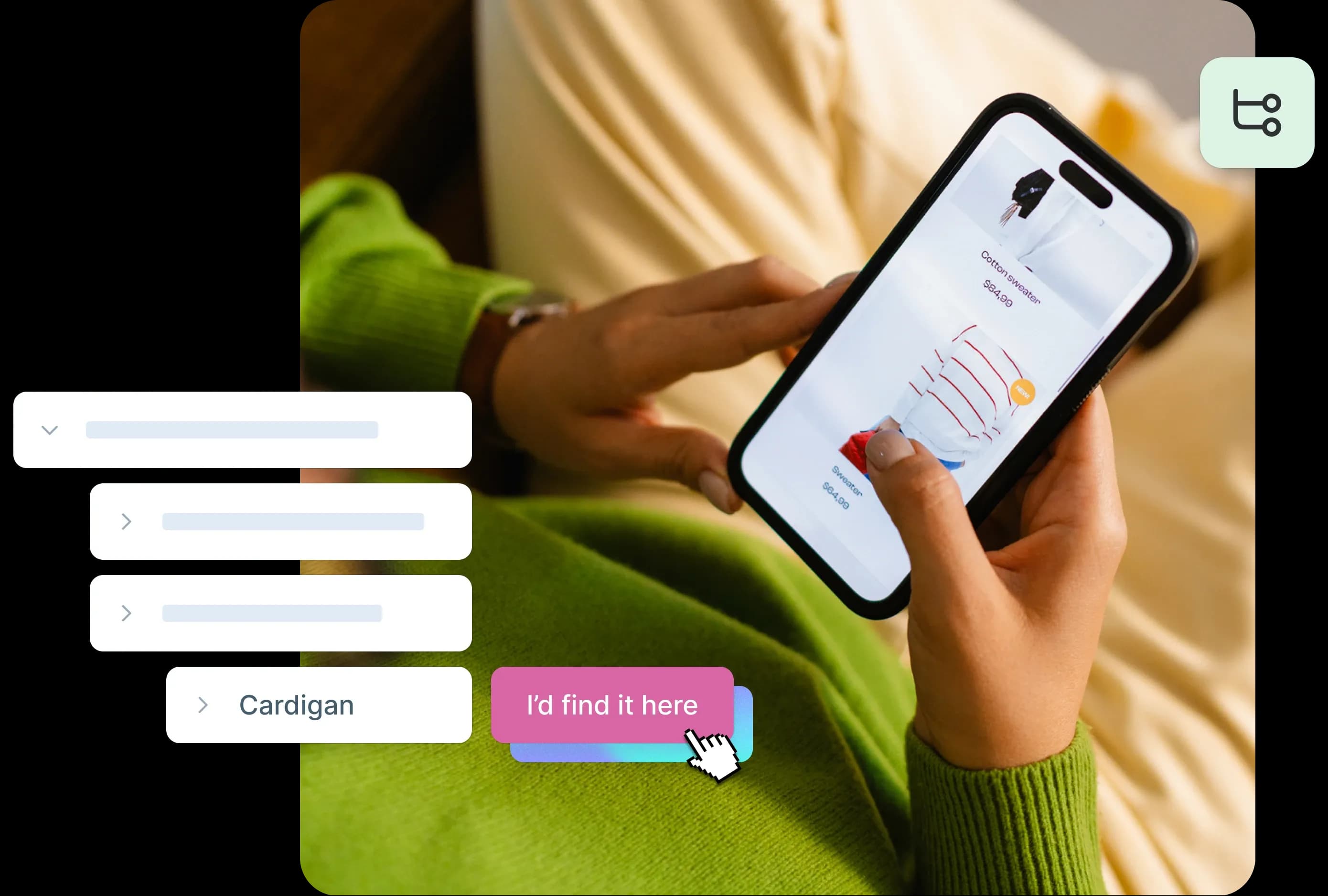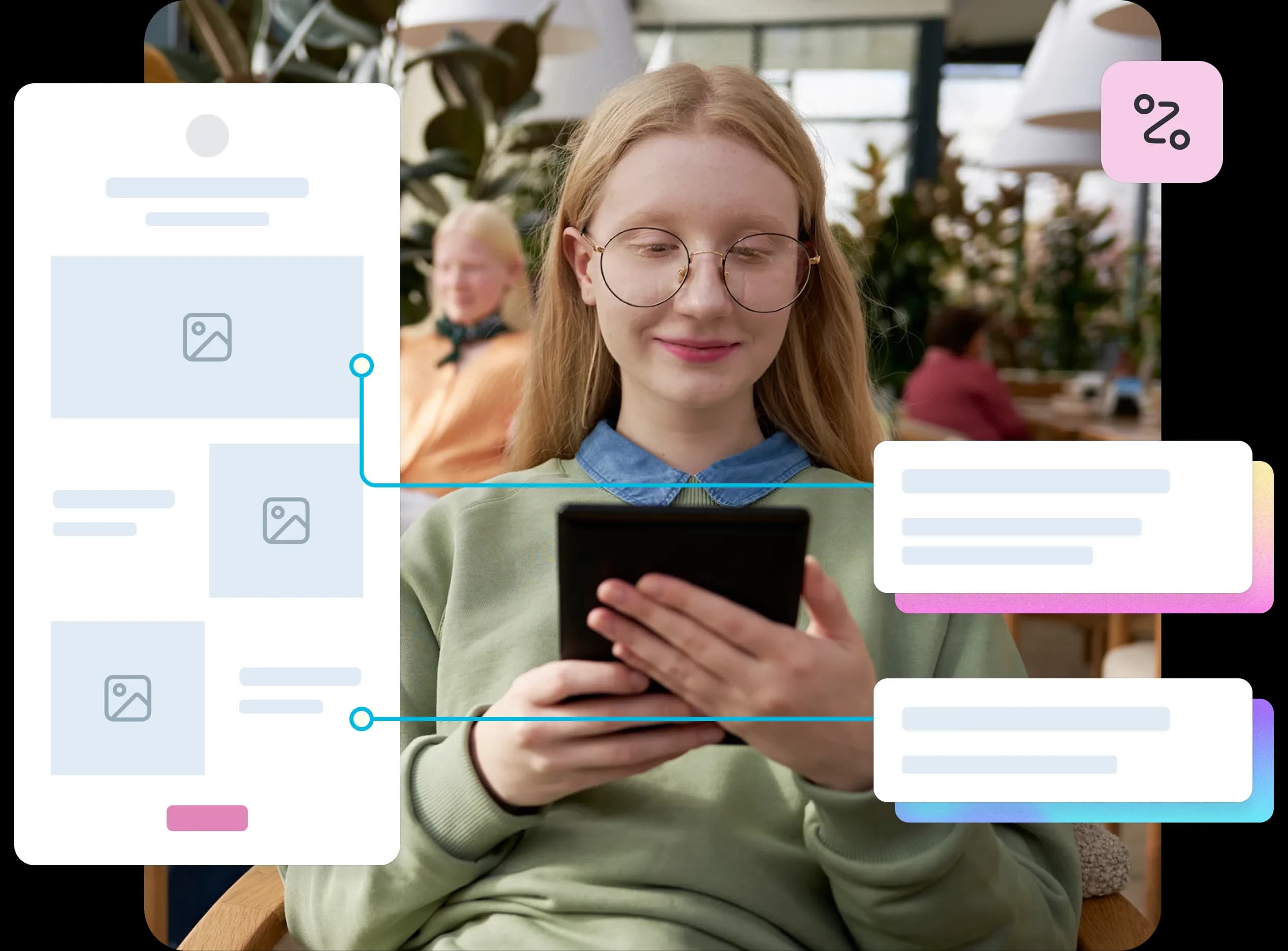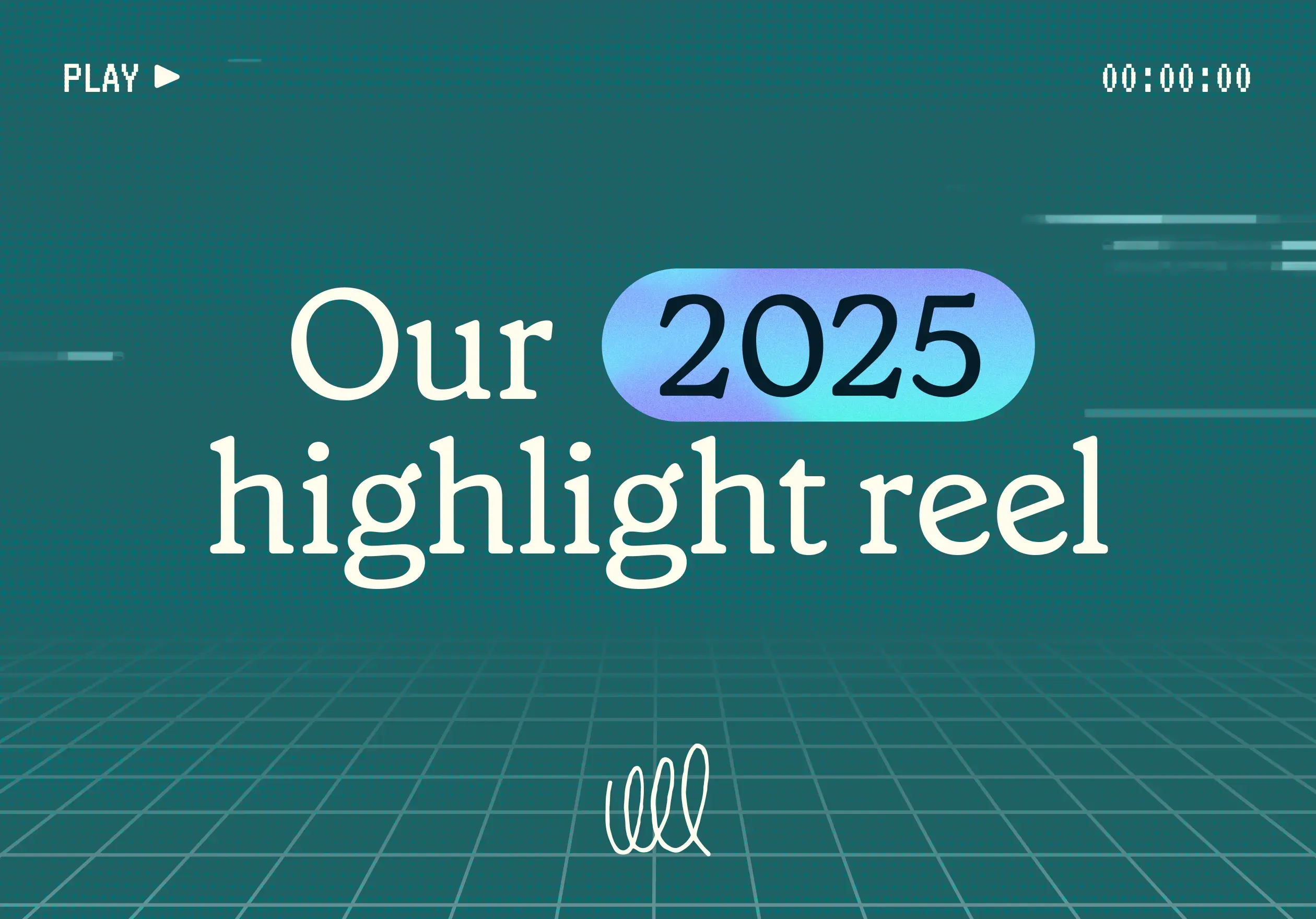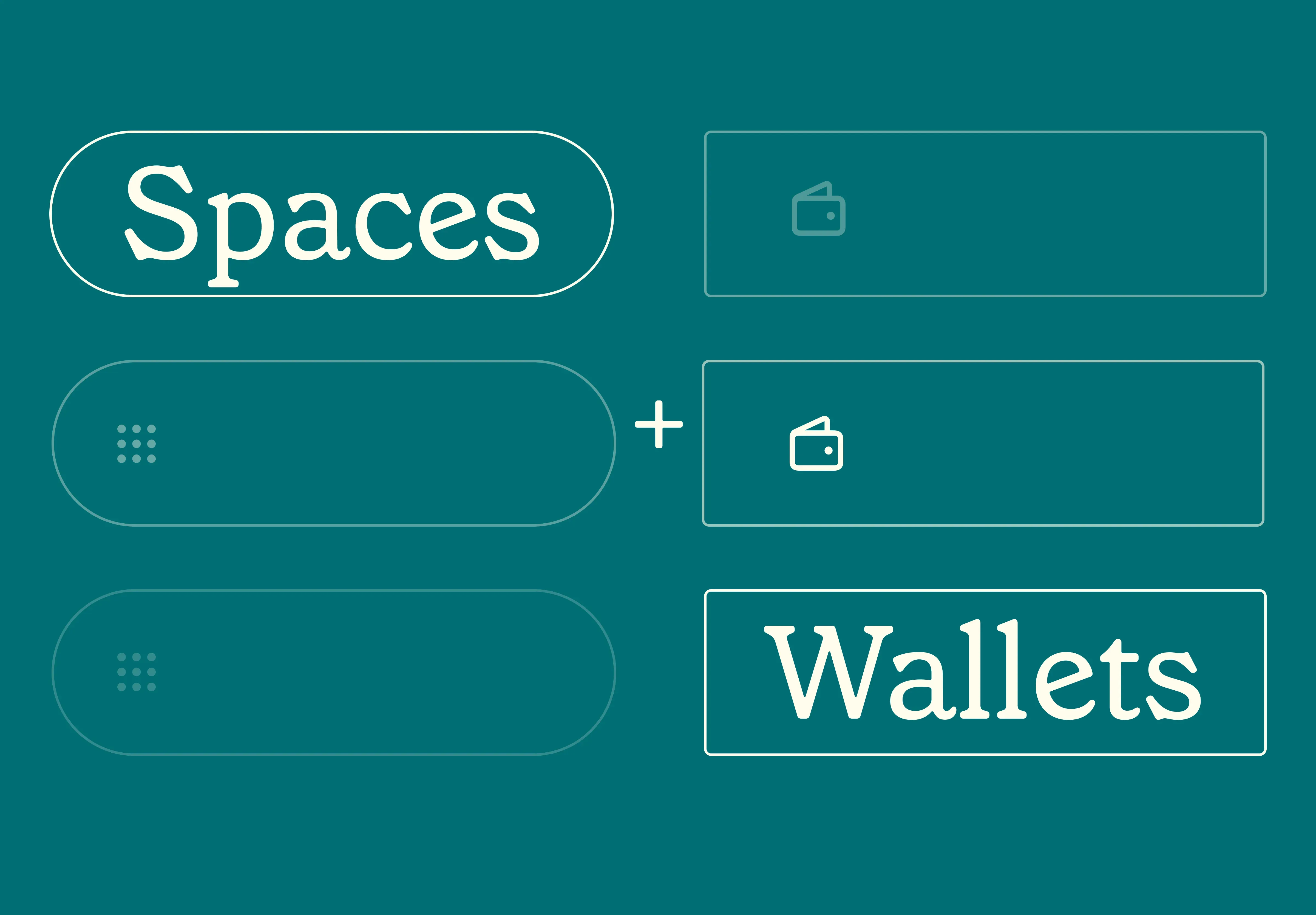18 Aug 2025
|14 min
New product development process
A complete guide to the product development process, from idea to launch. Learn stages, strategies, and expert tips to build successful, user-driven products.
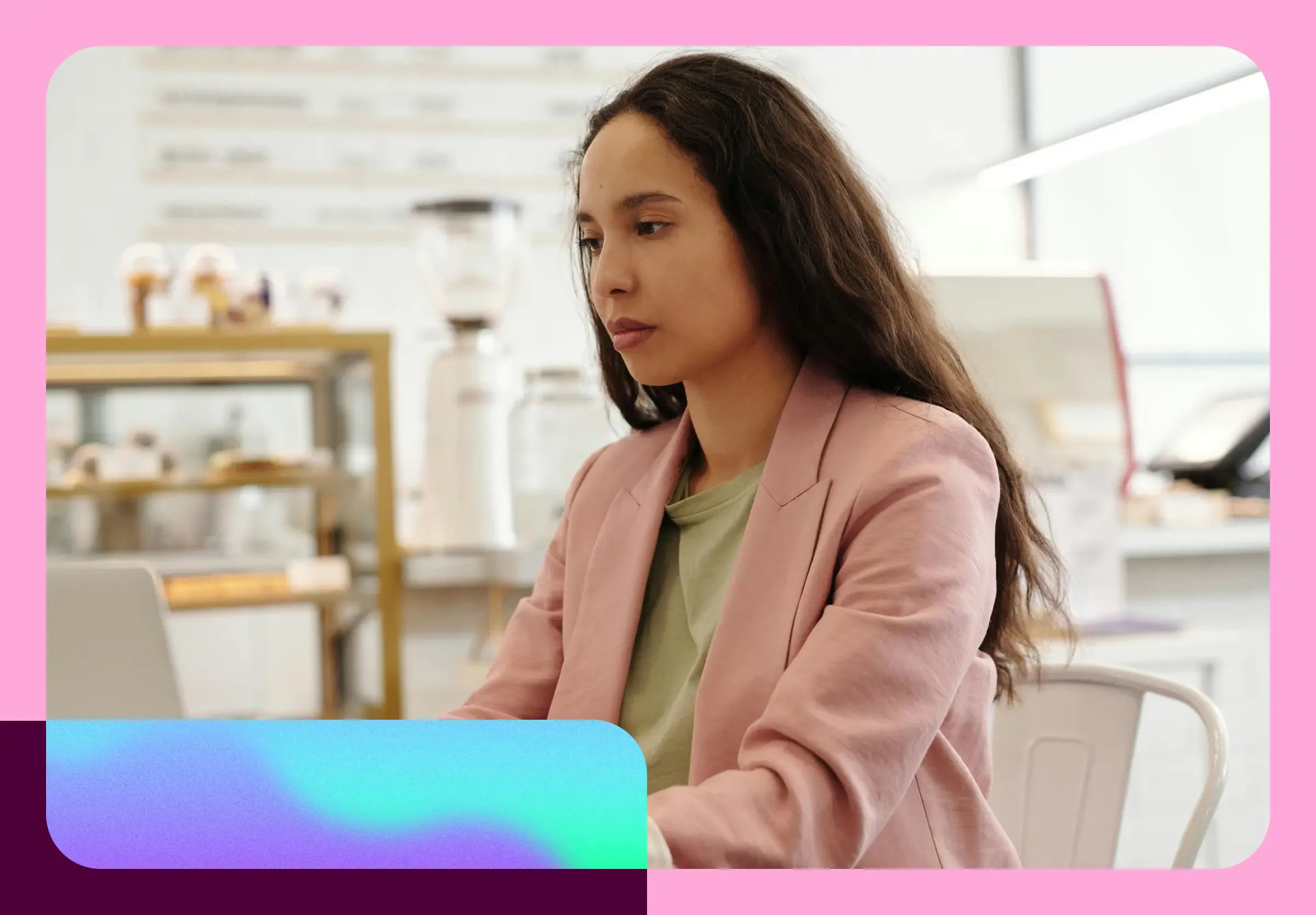
What do the iPhone, the first piloted flight, and your next big idea have in common?
They all succeeded because of a structured new product development process – a step-by-step approach that turns ideas into impact.
But as Jim Euchner points out in The Speed of New Product Development (Journal of Research-Technology Management):
“The pace of change is accelerating, and the tools that have served NPD well for decades are beginning to fail.”
This guide isn’t just a walkthrough of the new product development process – it’s a modern take. You’ll learn how to adapt classic stages to today’s fast-moving market, avoid outdated pitfalls, and bring better products to market, faster.
Key takeaways:
Step-by-step new product development (NPD): Move from rough ideas to successful launches, one validated step at a time.
Innovation with research: Interviews, journey mapping, and prototype testing reduce risk and improve outcomes.
Smart prioritization: MVPs, opportunity trees, and scoring systems help iterate faster and focus on what matters.
Collaboration is essential: Product managers, designers, researchers, engineers, and marketers should be involved from day one.
Lyssna helps every stage: From idea validation to prototype testing and post-launch insights.
Validate your next big idea
Ready to turn concepts into successful products? Start testing your ideas today with Lyssna. Get real feedback at every development stage and launch with confidence.
What is new product development?
New product development is the structured process businesses use to:
Bring a new product to market.
Introduce an existing product to a new market.
Undertake a major redesign of an existing product.
While the concept is simple, the process involves multiple iterative stages to reduce risk, validate ideas, and ensure market fit.

Benefits of an effective new product development process
A strong NPD process acts like R&D-driven insurance: it lets you place small bets early rather than risking everything late. Benefits include:
Adapt to changing market needs: Spotify pivoted into podcasts to meet evolving user interests.
Fuel growth and revenue: Netflix transformed from DVD rentals to streaming and original content.
Drive industry-wide innovation: Apple’s iPhone reshaped multiple industries.
Stand out from competitors: Oatly dominated the oat milk market with bold branding.
Build long-term brand relevance: Adobe shifted to Creative Cloud subscriptions, staying relevant to new generations.
Lyssna can help you validate ideas and iterate at every step, making sure your bets are informed by real user feedback.
Next, we'll break down the nine key phases of modern new product development. For each one, we’ll explore what it involves, how to approach it, and where tools, research, or testing can give you a sharper edge.
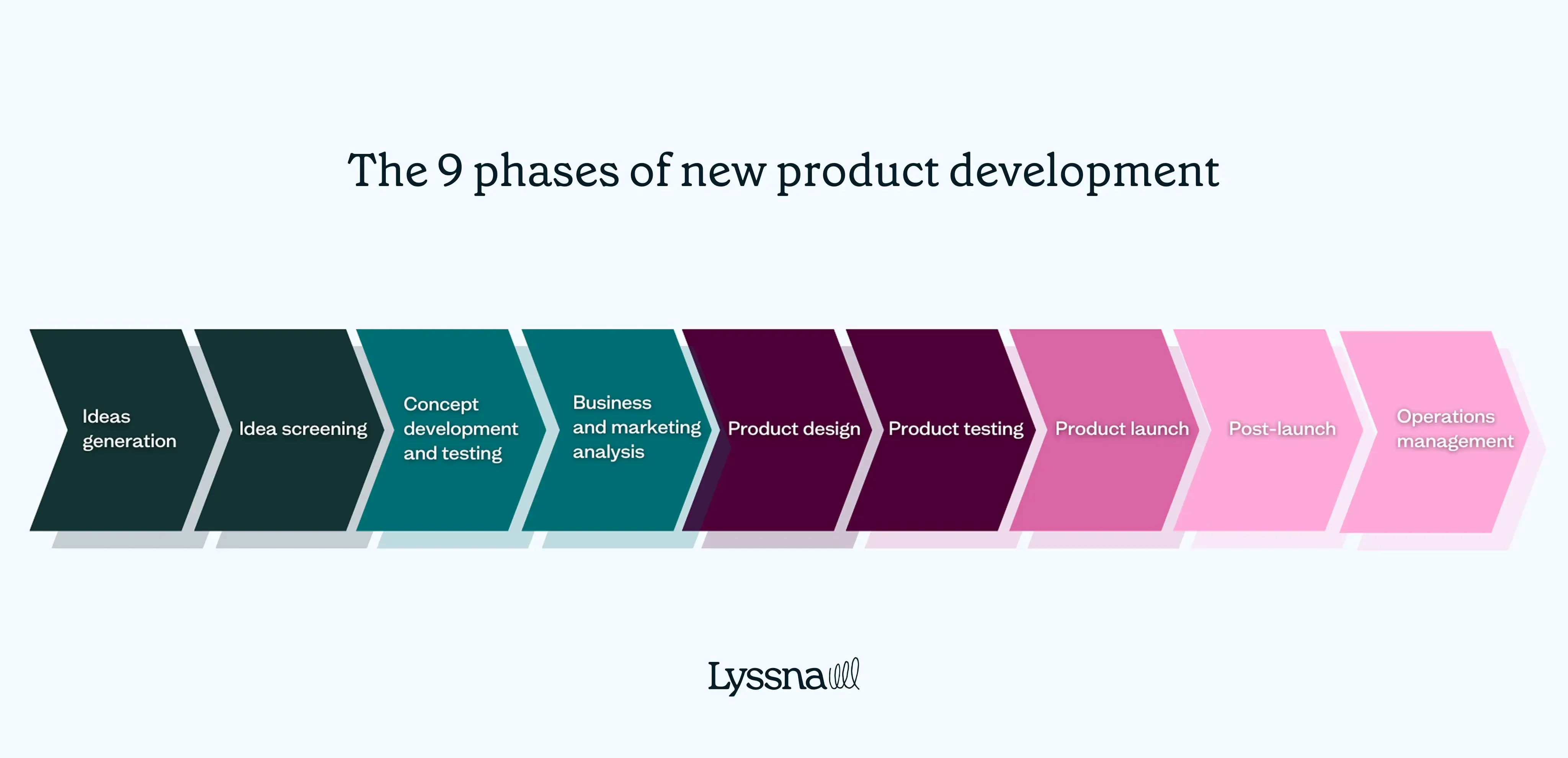
Idea generation
Great products start with great ideas – but not every idea is worth building. Structured ideation helps you generate and evaluate ideas systematically.
Key steps:
Understand your market: Who are you solving for, and what problems matter most? Ground ideas in user research, journey mapping, or exploratory interviews.
Evaluate competitors: Identify gaps and unmet needs. Spot outdated experiences or opportunities to improve.
Use ideation frameworks: Tools like SCAMPER (Substitute, Combine, Adapt, Modify, Put to another use, Eliminate, Reverse) push thinking beyond the obvious.
Tap into multiple sources: Customers, frontline teams, partners, and employees can all spark innovation. Brainstorm cross-functionally or review support tickets and feedback for trends.
Document promising concepts early: One-pagers outlining the problem, solution, target user, and business value make it easy to spot promising ideas.
Lyssna use case: Use Lyssna’s early concept validation tests to quickly gauge whether users connect with your concepts before investing heavily.
As Diana Stepanova, Operations Director at Monitask, puts it:
“Encourage open communication and collaboration within your team and establish a clear process for submitting and vetting new ideas. This process should include prioritization based on the value proposition, feasibility, and alignment with company goals.”
Pro tip: Set clear criteria to evaluate ideas upfront – like strategic fit, user impact, and estimated effort. Otherwise, you risk ending up with the next Google Glass: innovative on paper, but out of touch with what real users want (or were willing to wear in public …).

Idea screening
Not every idea should move forward. Idea screening separates the “maybes” from real contenders.
Focus areas:
Feasibility: Can it be built within budget, timeline, and technical constraints? Involve product and engineering early to assess risk and dependencies.
Market fit: Does it solve a real problem and align with business goals? Use user research or moderated interviews to validate needs before you dive into design.
Prioritization frameworks: Use tools like Opportunity Trees, RICE scoring, or weighted prioritization grids to reduce bias and bring structure to decision-making.
Lyssna use case: Run user interviews with Lyssna to see which ideas resonate most with real users, reducing guesswork.
Pro tip: Involve stakeholders early to avoid later friction. A quick workshop using a decision matrix or opportunity solution tree can align cross-functional teams before sunk-cost bias kicks in.

Concept development and testing
With your top ideas selected, it’s time to define and test them. Focus on your product’s value, target audience, and key features.
Key steps:
Outline core benefits: Who is it for, and why does it matter? Keep it high-level. Example: a budgeting app might promise “automated savings for busy professionals.”
Test multiple variations: Try different angles. Early Airbnb messaging tested cheaper hotels, personal travel experiences, and meeting locals. “Belonging anywhere” resonated emotionally.
Validate with users: Use surveys, interviews, or preference tests. Do users understand it? Want it? Does one version stand out? Early feedback confirms direction – or signals it’s time to refine.
Lyssna use case: Test multiple concepts using Lyssna’s preference tests to see which version performs best.
Pro tip: You don’t need a polished design to test a concept. Even a rough mockup is enough to spot what resonates and what misses the mark.

Business and marketing analysis
With concept validation done, focus on viability: does the product make business sense financially, strategically, and in the market?
Initial positioning and pricing
Define your niche and value proposition. What sets your product apart? What’s the “why now” for your audience?
Learn from competitors: analyze strengths, identify gaps, and chart your course. Matthew Ramirez – who built and sold WriteLab to Chegg (later becoming Director of Product Management) puts it this way: “Scrutinize your rivals and learn from their strengths. Then identify the product that poses a challenge, conduct a SWOT analysis, and chart a course of action.”
Conduct pricing research and draft a pricing strategy based on perceived value and competitor benchmarks. No need for exact figures yet – just a sense of what users might pay.
Sales projections
Forecast outcomes using early demand signals and benchmarks. Build conservative and optimistic scenarios.
Consider conversion rates, usage frequency, retention curves, and lifetime value.
Costs and risks
Estimate development, marketing, support, and distribution costs.
Identify key risks (technical, market, or operational) to flag red flags early.
Messaging framework
Don’t worry about polished copy yet. Sketch a rough value proposition and key talking points to guide positioning and future go-to-market assets.
Lyssna use case: Run surveys to determine willingness to pay or pricing sensitivity before finalizing your pricing strategy. Our pricing model survey template is a good place to start.

Product design
Design brings your concept to life.
Key steps:
Build detailed prototypes using prototyping tools.
Collaborate with designers, engineers, and researchers.
Validate design decisions early with usability testing.
Lyssna use case: Test prototypes with target users to refine flows and interactions.
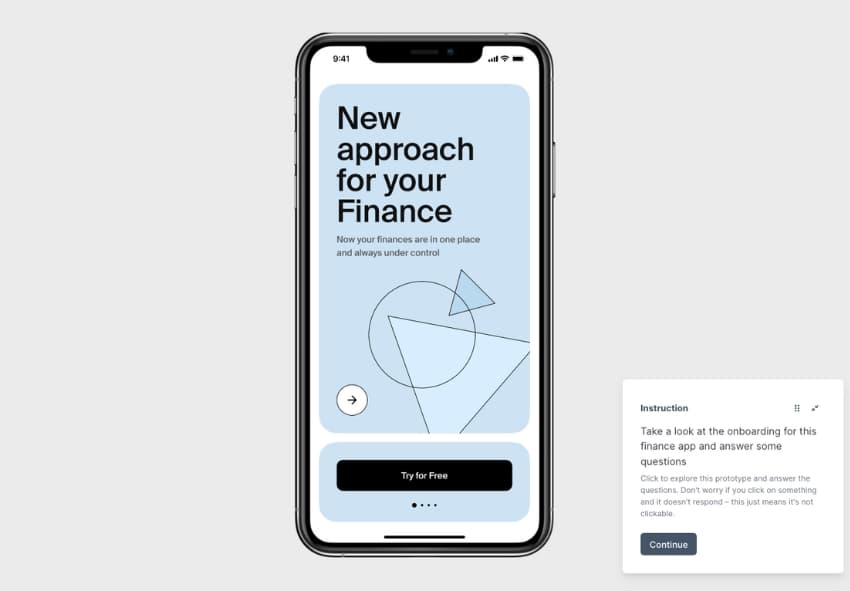
Building detailed concept designs and prototypes will probably require a designated UX designer or a team of designers. Alok Agarwal, VP of Products at Mailmodo, says this is essential:
“You must work with a team of designers to create a prototype of the product. Test the prototype with customers to get feedback and make changes accordingly.”
Pro tip: Don’t fall in love with your first design. Use rapid prototyping to create multiple versions, and test early with real users. The goal isn’t perfection – it’s progress. And yes, even your “perfect” idea will probably need a tweak or two.

Product testing
With your prototype built and designs validated, test the product in real-world conditions to reduce risk and refine quality before launch.
Alpha vs beta testing
Alpha: Internal testing to catch bugs, UX issues, and edge cases.
Beta: Limited external release to see real-world performance and gather actionable feedback.
“Set up proper test environments and utilize usability testing tools and techniques to ensure the product is stable, secure, and scalable. Collect feedback through multiple channels – customer interviews, usability tests, alpha testing, and beta testing – to drive continuous improvements.” – Diana Stepanova, Operations Director @ Monitask
Front-end vs back-end testing
Front-end: UI flows, design consistency, interactive elements.
Back-end: APIs, databases, load handling, and system stability.
Both are essential for a smooth user experience.
Soft launch and test marketing
Release to a small audience or region to test adoption and messaging.
Treat it as a rehearsal to make final adjustments before a full launch.
Lyssna use case: Capture user feedback across multiple touchpoints to uncover hidden pain points before launch.

Commercialization and launch
Finalize your go-to-market plan:
Align product, marketing, sales, and support teams.
Track metrics to check readiness and early success.
Communicate value clearly to your target audience.
At this stage, Diana Stepanova from Monitask also echoes these needs:
“Develop a go-to-market strategy that clearly communicates your product's value proposition and differentiators. This can include marketing campaigns, product demonstrations, and sales funnel optimization. Continuously gather feedback to adjust your product roadmap and fine-tune your marketing efforts.”
Lyssna use case: Conduct usability tests for your landing pages, onboarding flows, or marketing campaigns before going live.

Post-commercialization
Launching isn’t the finish line – it’s just the next phase. Focus on learning from real-world use and making continuous improvements.
As Alok Agarwal, VP of Products at Mailmodo, emphasizes: “Monitor the product's performance after it is launched. Collect data on sales and customer satisfaction, then use this data to make changes to the product or marketing strategy.”
Key focus areas:
Track performance: Monitor sales, usage, retention, and support tickets to spot trends.
Collect feedback: Surveys, interviews, and support channels reveal what’s working and what’s not.
Prioritize improvements: Tackle issues that impact revenue or satisfaction first.
Communicate updates: Keep users informed – transparency builds trust and retention.
Lyssna use case: Use ongoing unmoderated testing to monitor feature adoption and user satisfaction post-launch.

Operations management
The final stage of new product development focuses on efficient workflows, process reviews, and enhancing customer support.
Given her role as an operations director, Diana has some practical tips to share about this stage:
“Streamline processes and workflows to ensure efficient product delivery, from development to customer support. Utilize project management tools, maintaining a balance between innovation and operational efficiency. Regularly review your product and project management strategies to ensure they properly support your overall business goals.”
Key priorities:
Optimize workflows: Make processes efficient from development through to support.
Review regularly: Ensure project management and product strategies align with business goals.
Enhance customer experience: Use operations insights to improve support and satisfaction.
New product development is ongoing – operations management helps cement your product as a core or supplemental business offering.

Expert tips for building better products
Do you have an idea ready for development and are willing to put in the hard work to get it to market? Before you run off into the sunset, bear in mind these tips and best practices to help you stay on track for a successful launch.
Iterate constantly
It should be a no-brainer to say that whenever you test your product, you should make improvements based on the results. This is similar to the continuous product discovery process.
“Embrace an iterative approach, incorporating user feedback and continuous improvement throughout the development process.”
— Akash-Roy, Product Manager at Napta
Test in multiple environments
Just because your prototype works for someone in one type of environment or situation doesn’t mean it works for everyone else. When product testing, vary your test situations or make sure your participants are diverse.
“Make sure the product is reliable and meets all of the requirements [from your business analysis]. Test it in a variety of environments.”
—Alok Agarwal, VP of Products at Mailmodo
Embrace experimentation
I came across an inspiring product story on Twitter shared by @tibo_maker, the Co-founder of Tweet Hunter. When he set out to develop a new product, he embraced experimentation to validate ideas before making significant commitments. In just four months he created 11 different products, and eventually found success with Tweet Hunter.
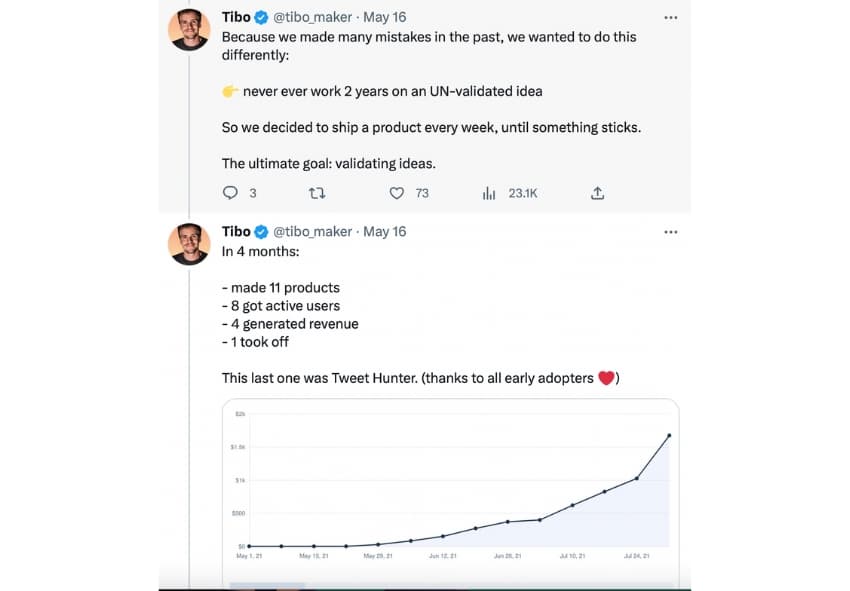
Image source: Twitter
You don’t have to experiment with as many ideas as Tibo did, but you can experiment in other areas such as implementing AI or using hybrid models with Stage Gate to boost your chances of success.
New product development process examples
Want to see these principles in action? Here are three real-world examples of how teams applied the product development process to bring new ideas to life, from tech to consumer goods.
#1: Airbnb
The founders of Airbnb began by validating their concept in the scrappiest way possible: renting out air mattresses in their San Francisco apartment during a local conference (yes, really!). Through rapid iteration and real-time user feedback, they moved from concept testing to a scalable MVP that redefined travel and hospitality.
#2: Dropbox
Before building a full-fledged product, Dropbox founder Drew Houston created a short explainer video demonstrating the concept of seamless file synchronization across devices. Released on Hacker News in 2007, the video effectively communicated the product's value proposition and generated significant interest, leading to a waiting list of over 75,000 people overnight. This approach allowed Dropbox to validate the market need and refine its offering before investing heavily in development.
Example 3: LEGO
Facing declining sales and a lack of engagement from female consumers, LEGO embarked on extensive ethnographic research to understand how girls play. The company discovered that girls preferred role-playing and storytelling with figures that had more realistic proportions and relatable narratives. This insight led to the development of the LEGO Friends line, featuring mini-dolls and sets designed to align with these preferences. The result? A reinvigorated brand and double-digit growth.
Key team members in the product development process
Bringing a new product to life is a cross-functional effort. From insight to execution, each stage requires input from specialized team members. While team structure may vary by company size or industry, here are the core roles that commonly shape a successful product development process:
Product manager: Owns the vision and roadmap. Aligns cross-functional teams, prioritizes features, and ensures the product solves real user problems while meeting business goals.
UX researcher: Gathers user insights through interviews, surveys, and usability testing. Helps identify user needs, validate concepts, and reduce risk through data.
UX/UI designer: Translates user needs and research into functional, engaging designs. Creates prototypes and user flows that guide both users and developers.
Engineer/developer: Brings the design to life. Collaborates closely with product and design teams to ensure feasibility and execution across front and backend systems.
Marketing lead: Shapes the go-to-market strategy. Crafts messaging, positioning, and campaigns to ensure the product reaches the right audience with a compelling story.
Operations/project manager: Keeps the wheels turning. Manages timelines, deliverables, and team coordination to ensure a smooth, on-time launch.
Start testing, stop guessing!
Don't leave your product's success to chance. Try Lyssna and access unlimited user tests to validate your concepts, designs, and prototypes before launch.
FAQs

Alexander Boswell
Technical writer
Alexander Boswell is a product-led content writer and researcher with a background in marketing strategy and consumer behaviour. When he’s not writing, he’s playing baseball and D&D.
You may also like these articles


Try for free today
Join over 320,000+ marketers, designers, researchers, and product leaders who use Lyssna to make data-driven decisions.
No credit card required
